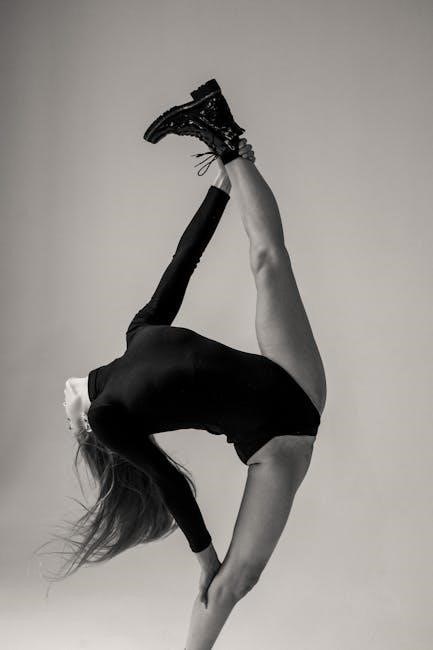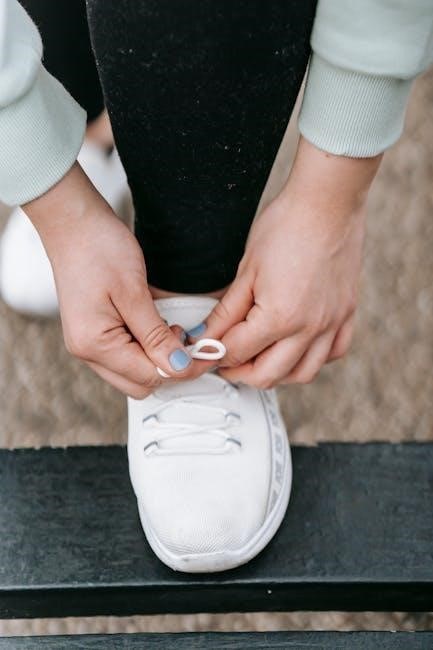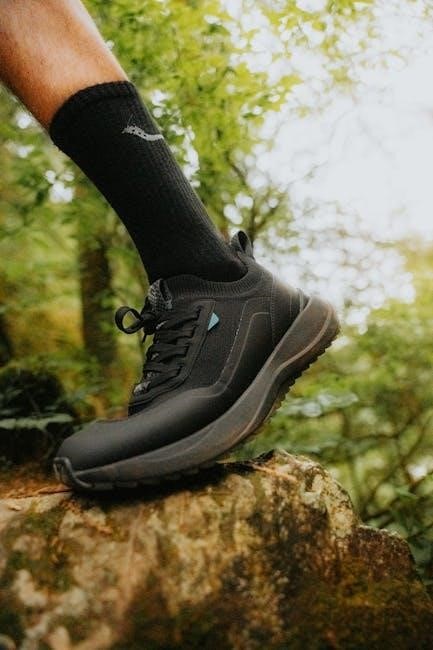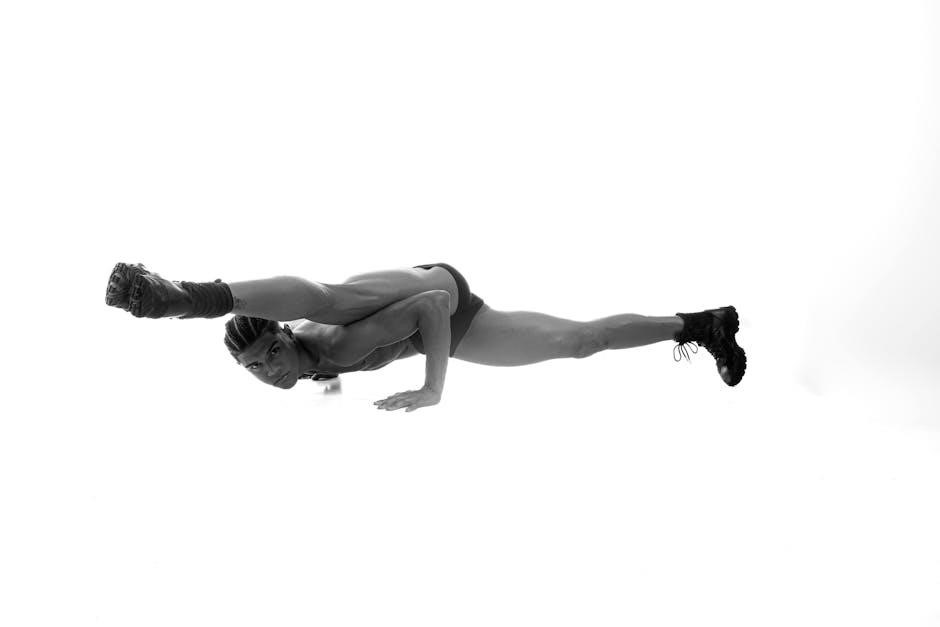Discover the essential tips for finding your perfect Danner boot fit. This guide covers sizing, width options, and expert advice to ensure comfort and performance for every adventure.

Danner Boot Sizing Basics
Danner boots are sized using the Brannock device for US measurements. They offer sizes from men’s 7 to 15 and women’s 5 to 12, with narrow, standard, and wide widths.
Understanding Length and Width Options
Choosing the right length and width is crucial for a comfortable fit. Danner boots are available in various lengths to accommodate different foot sizes, ensuring your toes have enough space without feeling cramped. When it comes to width, options include narrow (B), standard (D), and wide (EE). If you have wider feet, opting for a wider width or even a half-size up can provide extra comfort and prevent tightness. Proper length ensures your foot isn’t restricted, while the right width avoids pressure points. These options are designed to meet individual needs, whether for hiking, work, or everyday wear, ensuring a comfortable and functional fit.
How to Measure Your Feet Accurately

Measuring your feet accurately is the first step to finding the perfect fit. Start by standing on a flat surface with your weight evenly distributed. Use a Brannock device or a ruler to measure the length and width of both feet, as they may differ. Measure in the afternoon, as feet tend to swell slightly throughout the day. For length, measure from the heel to the tip of your longest toe. For width, wrap a flexible measuring tape around the widest part of your foot. Record both measurements and compare them to the Danner size chart to determine your ideal fit. This ensures a comfortable and precise match for your boots.
Danner Size Chart and Width Options Explained

Danner offers a comprehensive size chart with options ranging from men’s 7 to 15 and women’s 5 to 12. The brand provides three width choices: narrow (B), standard (D), and wide (EE), ensuring a tailored fit for various foot shapes. The size chart is based on the Brannock device, the industry standard for accurate footwear sizing. To use the chart effectively, measure your feet in the afternoon when they are at their largest. Compare your measurements to the chart, selecting the size that accommodates your longest toe and widest point. This ensures optimal comfort and support, whether you’re wearing the boots for work or hiking. By considering both length and width, you can find a pair that feels customized to your feet.
Trying On Danner Boots: Tips for the Best Fit
Ensure a perfect fit by trying on Danner boots in the afternoon, wearing appropriate socks, and checking for ample toe room. Walk around to gauge comfort and support.
Why You Should Try Boots On in the Afternoon
Trying on Danner boots in the afternoon ensures the best fit because feet naturally swell throughout the day. This swelling can make your feet up to a half size larger, so testing boots in the afternoon provides a more accurate fit. Early morning try-ons might result in a boot that feels too tight later in the day. By waiting until afternoon, you account for this swelling, ensuring the boots will remain comfortable all day long. This simple tip helps prevent discomfort and ensures a more precise fit for optimal performance and comfort.
Importance of Wearing the Right Socks
Wearing the right socks is crucial when trying on Danner boots to ensure a proper fit and comfort. The thickness and material of your socks can significantly impact how the boots feel. For hiking or work boots, opt for thick wool or cushioned socks, as they provide the necessary support and moisture-wicking properties. Wearing the wrong type of socks can lead to a poor fit, causing issues like tightness or blisters. When trying on boots, use the same socks you plan to wear with them to get an accurate sense of the fit. This ensures the boots will perform as intended during your activities.
How to Check for Proper Toe Room
Proper toe room is essential for comfort and performance in Danner boots. To check for adequate space, ensure there is about a thumb’s width between your longest toe and the boot’s end. You should be able to wiggle your toes slightly without feeling cramped. If the toe box feels too tight, consider a wider width or a half-size up. Conversely, if there’s excessive room, the boots may not provide sufficient support. Walk around while wearing the boots to ensure no pressure points or discomfort. Proper toe room ensures a comfortable fit and prevents issues like blisters or restricted movement during activities.
Common Danner Boot Fit Issues and Solutions
Tightness, heel slip, and arch pain are common issues. Solve them by choosing wider widths, adjusting lacing, or opting for models with better support and cushioning.
Tightness in the Toe Box: When to Choose a Wider Width
If you experience tightness in the toe box, it may be due to narrow boot width. Danner boots offer various widths, including narrow, standard, and wide (EE). Opting for a wider width can alleviate pressure and enhance comfort. Additionally, considering a half-size up can provide extra room for your toes. Proper toe room is essential for preventing discomfort and potential issues like bunions or calluses. Use the Danner size chart to explore width options and ensure a comfortable fit. Remember, a snug yet non-restrictive fit is ideal for optimal performance and all-day wear.
Addressing Heel Slip and Ankle Rubbing
Heel slip and ankle rubbing are common issues that can detract from your hiking or work experience. Tightening the laces, especially around the ankle, can often resolve heel slip. Additionally, employing a heel lock lacing technique ensures a more secure fit. For ankle rubbing, consider a boot with a lower or higher cut, depending on your needs, or use ankle padding for extra cushioning. If these issues persist, it may be worth exploring a different boot model with a more tailored fit. Proper lacing and boot selection are key to eliminating discomfort and ensuring a smooth, enjoyable experience in your Danner boots.
How to Handle Arch Pain and Support Needs

Arch pain can hinder comfort and performance in your Danner boots. If you experience arch discomfort, consider boots with built-in arch support or opt for custom orthotics to address specific needs. Many Danner boots feature sturdy arch support, but for high arches or flat feet, additional insoles may be necessary. Ensure proper lacing to prevent excessive pressure on the arches. If pain persists, consult a professional fitter to find the best boot and support combination for your foot shape. Addressing arch pain early ensures long-term comfort and prevents potential injuries during hikes or work.

Breaking In Your Danner Boots
Danner boots require a gradual break-in process for optimal comfort. Start with short wear sessions and increase duration over weeks to mold the leather to your feet.
Why Breaking In is Essential

Breaking in your Danner boots is crucial for achieving long-term comfort and performance. New boots are stiff and require time to mold to your foot shape, ensuring a personalized fit. Skipping this process can lead to discomfort, blisters, and poor support during hikes. By gradually wearing them, you allow the leather to soften and adapt, reducing friction points. This step is especially vital for high-quality leather boots, as it enhances durability and support. Start with short wear sessions and gradually increase time. Patience during this process ensures a comfortable, tailored fit that will last for years of adventure;
Gradual Break-In Process for Comfort
Achieve optimal comfort with a gradual break-in process for your Danner boots. Start by wearing them indoors for short periods, allowing the leather to mold naturally. Gradually increase wear time and intensity over a few weeks. Pair with merino wool socks to reduce friction and prevent blisters. For tougher leather, consider applying leather conditioner. Walking around the house or taking short walks helps soften the material. Avoid rushing the process, as this can cause discomfort and extend the break-in period. Consistency ensures a comfortable fit, making your boots feel like a second skin for years of reliable performance and support.
Frequently Asked Questions About Danner Boot Fit
Explore common questions about Danner boot fit to ensure your boots provide comfort and support. From sizing charts to break-in tips, find answers to your most pressing concerns. Learn how to measure your feet accurately, understand width options, and address fit issues. Discover the importance of trying boots on in the afternoon and wearing appropriate socks. Get insights into handling tightness, heel slip, and arch support. Understand how to break in boots gradually for optimal comfort. Whether you’re a first-time buyer or a seasoned wearer, these FAQs offer practical advice for a perfect fit, ensuring your Danner boots deliver exceptional performance and comfort for every adventure.
